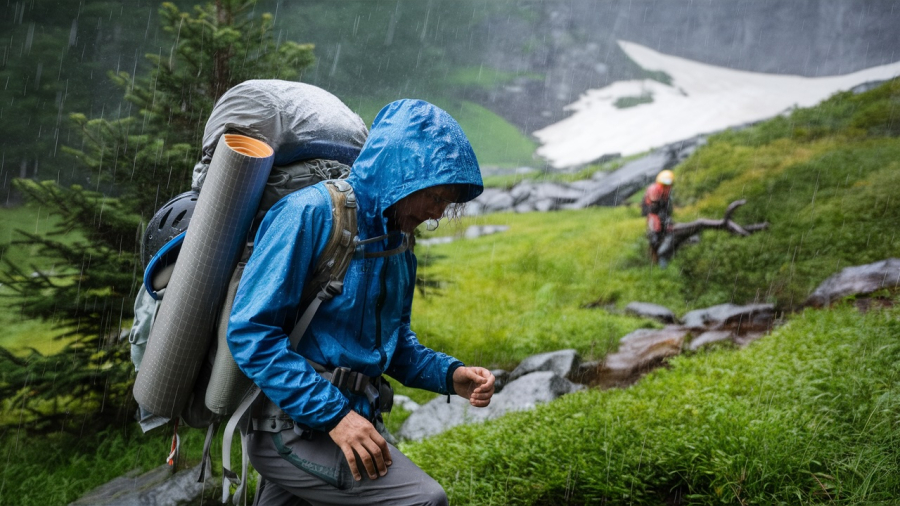The mountainous provinces of Ha Giang, Son La, and Lao Cai in Northern Vietnam are always alluring destinations for adventurous travelers. Regardless of the weather, the scenic landscapes of the Northwest region never fail to captivate visitors.
But how can you ensure a safe and pleasant mountain trip during the rainy season? Check out the invaluable tips below to prepare for your journey!
Stay updated with weather forecasts
First and foremost, keep a close eye on the weather, not only at your destination but also in the surrounding areas. Mountainous roads often traverse high altitudes, resulting in varying temperatures and rainfall compared to other regions. Thus, it’s crucial to pack accordingly for diverse weather conditions.
As over 90% of the routes to these northern mountainous provinces involve treacherous passes, paying attention to weather forecasts is vital. Avoid traveling through passes during heavy rain or strong winds. If there’s a forecast for storms or heavy rain, find a safe place to halt your journey until the weather improves.
Areas with high peaks, barren hills, or dense electrical wiring are best avoided during rain. Should the weather deteriorate, it’s advisable to remain in your accommodation or designated safe areas specified by the locals.

Stay informed about weather conditions, not just at your destination but also in nearby areas.
Prepare your gear for a rainy mountain adventure
Equipping yourself appropriately is paramount. Instead of a regular suitcase, opt for a waterproof backpack to carry your essentials when traveling to the mountains during the rainy season.
For rainy conditions, prioritize waterproof clothing and shoes with good traction. Additionally, a hairdryer, waterproof bags for your belongings, and cold medicine will come in handy.
Avoid wearing damp clothes, especially bulky and heavy garments, as they can cause discomfort, itchiness, and skin irritation. If your shoes get wet, use newspaper or paper towels to absorb the moisture, then dry them with a hairdryer or let them air-dry in a well-ventilated area.
When bringing electronic devices, pack them carefully in waterproof bags and keep them close by. Don’t forget to bring chargers for your phone and camera, along with a power bank.
If you’re planning on camping in the forest, make sure to bring a tent, lighter, instant noodles, or dry food in case you need to spend the night outdoors.
Financial planning and contingencies for rainy-season mountain travel
To prepare for potential contingencies, such as extended stays or changes in transportation due to inclement weather, as well as canceled tour bookings, it’s advisable to carry a larger sum of cash than initially planned. If necessary, you can ask your relatives to send money to your account or borrow from your travel companions.
Always have backup plans in place to deal with unforeseen events, especially when traveling to the mountains during the rainy season. The weather can change abruptly, so consider alternative entertainment options instead of outdoor activities or sightseeing. Having contingency plans will enable you to manage the situation better and maintain a positive mindset throughout your trip.

Always have backup plans when traveling to the mountains during the rainy season.
Engage in weather-appropriate activities
When planning your mountain trip during the rainy season, focus on indoor activities such as visiting museums and exploring cultural and historical sites, rather than venturing into the wild. Although travelers seek novelty and adventure, extra caution is warranted in areas like steep passes, high mountains, dense forests, or powerful waterfalls, especially during unfavorable weather conditions.
You can still appreciate nature’s beauty and engage in outdoor activities in safer regions. Always adhere to instructions from management and rescue teams at tourist sites, and don’t hesitate to seek assistance from locals to ensure a safe journey.
Maintain good health
Lastly, good health is paramount to completing your journey and relishing various experiences. The rainy season often brings respiratory and digestive issues, so focus on boosting your immune system before each trip. Remember to carry essential medications and medical equipment and maintain body warmth.
Consume well-cooked food and drink boiled water during your travels to safeguard your health. Moreover, preserve your energy by engaging in moderate-intensity activities and ensuring sufficient rest. Regardless of your passion for exploring winding roads or untouched landscapes, avoid overexerting yourself or walking for extended periods.
The rainy season can make transportation challenging and perilous, so drive slowly and cautiously, avoiding flooded or landslide-prone areas. If possible, opt for public transportation and always abide by traffic regulations.
These are the key considerations for traveling to the mountains during the rainy season. Once you’re well-equipped, in good health, and mentally relaxed, you’re all set to embark on your mountain exploration!




































